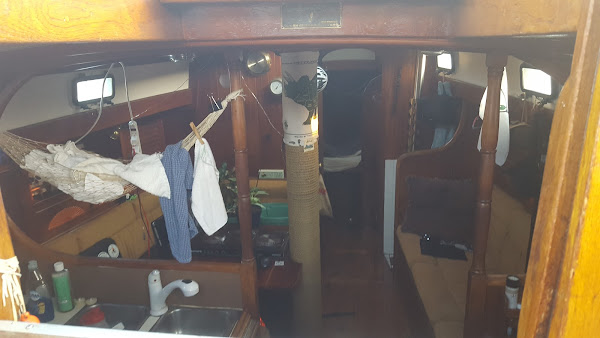Towards Electric Drive
This is Part 1 in a long journey.
Part 2: "Removing a Large Engine While in the Water"
Part 3. "Actual Engine Removal" is here.
Background
Why
What
Just slap on a new Balmar with an external regulator and call it done, right? Wrong. What was a "simple" $1000 replacement quickly ballooned to $3500 and four months because of other issues, custom fab, and interlocking dependencies. I'll spare you those details here.
The money, downtime, boat yoga, and additional problems with that diesel engine would have been better invested in converting the boat to electric drive. The engine could have been easily replaced with an inexpensive, small, light electric motor, but I only realized that in hindsight and after the costs had been sunk.
The seed was planted. My next sailboat is going to have electric drive.
Fuel tanks in the Formosa 46 are a timebomb. This is a 40 year old boat, so it is only a matter of time before one or both of the tanks spring a leak. The black steel fuel tanks are original and difficult to access, and therefore difficult to fully inspect. Water invariably collects in the bottom of the fuel tanks of any boat, which can result in corrosion of the tanks from the inside.
Diesel engines stink. They stink when running and they stink just sitting there The maintenance is stinky. Oil, oil filters, fuel, fuel-water separator, fuel filters: these all do their best to spill fluids during maintenance and contribute to that engine compartment smell. They are also noisy. While the Lehman is legendarily reliable, it makes a serious racket during operation. Part of the joy of owning a sailboat is silent operation; why mess that up with smell and (a lot of) noise?
There are a lot of ways to ease maintenance on a marine diesel. But there's still a huge, honkin' piece of iron in the engine compartment that makes things tricky. Much of my bilge is inaccessible for cleaning. Changing oil in this boat is also difficult. The oil drain plug is obscured and, because of the tilt of the engine, not even at the bottom of the oil pan.
Diesels have durable pistons (read: "huge, heavy chunks of metal going up and down"). While the vibrations are mitigated by an inline design, there is always going to be vibration. Electric motors have no reciprocating mass. They spin smoothly and quietly.
The input voltage is 48 V, which presents its own pros and cons. On the upside, 48 V is less hazardous than 400 V systems we were exploring. Also, we can "easily" power the rest of the boat with the 48 V bank. Any problem for which you can write a check... isn't a problem. Solar charging also becomes easier. Solar charge controllers are readily available for 48 V charging. There is a wide selection of 48 V inverters, so we can power AC loads off of the traction bank.
But lower voltage means higher amperage for the same propulsion. We are looking at over 600 A loads from the batteries. I believe the technical term is a "Shit-Ton of Amps" or "All The Electrions." This means much larger wires and batteries that must be mounted as close to the motor as possible. Even then, the wires need to be 4/0 (or 0000) gauge; this translates to a conductor diameter of about half an inch, with the lugs to match. Special tools are required and marine-rated wire is spendy.
We are choosing liquid cooled so as to limit how much heat we dump in the motor compartment. This is not much of an issue in the Pacific Northwest, but may become a factor in the tropics.
The traction battery bank will be 800 Ah comprised of 128 prismatic LiFePO4 cells. Yes, that is a lot of capacity and mass. Building a LiFePO4 bank involves a little more than grabbing a bunch of Interstate batteries and slapping them together. We will cover the traction bank, electrical diagrams, and planning in greater detail in later posts.
Future topics will be:
Part 2: Engine Removal While Still in the Water
Battery Bank In-Depth
Inspiration and Resources
Background
Why
What
Background
I wanted electric drive since my first sailboat. The voltage regulator in that boat died because the previous owner just dropped in AGM batteries while using the same internal voltage regulator. This can be a non-issue if AGM batteries are never deeply discharged. But I discharged the batteries to 60% on a long sail. AGM batteries can accept up to 50% Amps (A) of the Amps-hours (Ah) removed. For example, if 500Ah were taken out, the batteries will gladly gulp down 250A when the alternator gets energized. AGM batteries require a a regulator designed for the charge profile of that chemistry.Just slap on a new Balmar with an external regulator and call it done, right? Wrong. What was a "simple" $1000 replacement quickly ballooned to $3500 and four months because of other issues, custom fab, and interlocking dependencies. I'll spare you those details here.
 |
| Shiny new alternator, voltage regulator, mounting bracket, exhaust manifold, exhaust riser... |
The seed was planted. My next sailboat is going to have electric drive.
Why
The whys of choosing electric over diesel are legion. When considering torque alone, electric drive is unmatched. More torque, instant torque, less particular running issues. Diesels have specific operation parameters if you want longevity. They should be run for an hour under load once per week. This means that we have to consume diesel fuel just to own this chunk of iron. Diesels also do not take kindly to short run times; they should be run for at least an hour when used. This is in opposition to how I typically use my engine: getting in and out of marinas, and changing location when something urgent arises (like a ferry).Fuel tanks in the Formosa 46 are a timebomb. This is a 40 year old boat, so it is only a matter of time before one or both of the tanks spring a leak. The black steel fuel tanks are original and difficult to access, and therefore difficult to fully inspect. Water invariably collects in the bottom of the fuel tanks of any boat, which can result in corrosion of the tanks from the inside.
Diesel engines stink. They stink when running and they stink just sitting there The maintenance is stinky. Oil, oil filters, fuel, fuel-water separator, fuel filters: these all do their best to spill fluids during maintenance and contribute to that engine compartment smell. They are also noisy. While the Lehman is legendarily reliable, it makes a serious racket during operation. Part of the joy of owning a sailboat is silent operation; why mess that up with smell and (a lot of) noise?
 |
| See all that spaghetti? Yeah, that's how it came. |
There are a lot of ways to ease maintenance on a marine diesel. But there's still a huge, honkin' piece of iron in the engine compartment that makes things tricky. Much of my bilge is inaccessible for cleaning. Changing oil in this boat is also difficult. The oil drain plug is obscured and, because of the tilt of the engine, not even at the bottom of the oil pan.
Diesels have durable pistons (read: "huge, heavy chunks of metal going up and down"). While the vibrations are mitigated by an inline design, there is always going to be vibration. Electric motors have no reciprocating mass. They spin smoothly and quietly.
What
We are going to remove the Ford/Lehman 2712E diesel engine from our boat and replace it with an Electric Yacht QuietTorque 30.0 LC. We looked at a lot of different motors and even went far down the path of building our own system. In the end, The QT 30.0 was at the right intersection of price, features, support, product history, and company history. Yes, it was twice as expensive as a homebrew system, but homebrew brings a negative uniqueness. |
| It's so small and light and pretty and clean! |
The input voltage is 48 V, which presents its own pros and cons. On the upside, 48 V is less hazardous than 400 V systems we were exploring. Also, we can "easily" power the rest of the boat with the 48 V bank. Any problem for which you can write a check... isn't a problem. Solar charging also becomes easier. Solar charge controllers are readily available for 48 V charging. There is a wide selection of 48 V inverters, so we can power AC loads off of the traction bank.
But lower voltage means higher amperage for the same propulsion. We are looking at over 600 A loads from the batteries. I believe the technical term is a "Shit-Ton of Amps" or "All The Electrions." This means much larger wires and batteries that must be mounted as close to the motor as possible. Even then, the wires need to be 4/0 (or 0000) gauge; this translates to a conductor diameter of about half an inch, with the lugs to match. Special tools are required and marine-rated wire is spendy.
We are choosing liquid cooled so as to limit how much heat we dump in the motor compartment. This is not much of an issue in the Pacific Northwest, but may become a factor in the tropics.
The traction battery bank will be 800 Ah comprised of 128 prismatic LiFePO4 cells. Yes, that is a lot of capacity and mass. Building a LiFePO4 bank involves a little more than grabbing a bunch of Interstate batteries and slapping them together. We will cover the traction bank, electrical diagrams, and planning in greater detail in later posts.
Future topics will be:
Part 2: Engine Removal While Still in the Water
Battery Bank In-Depth
Inspiration and Resources



Comments
Post a Comment